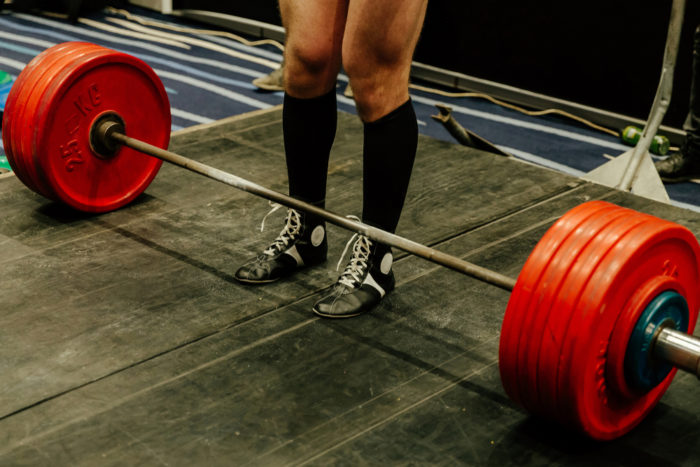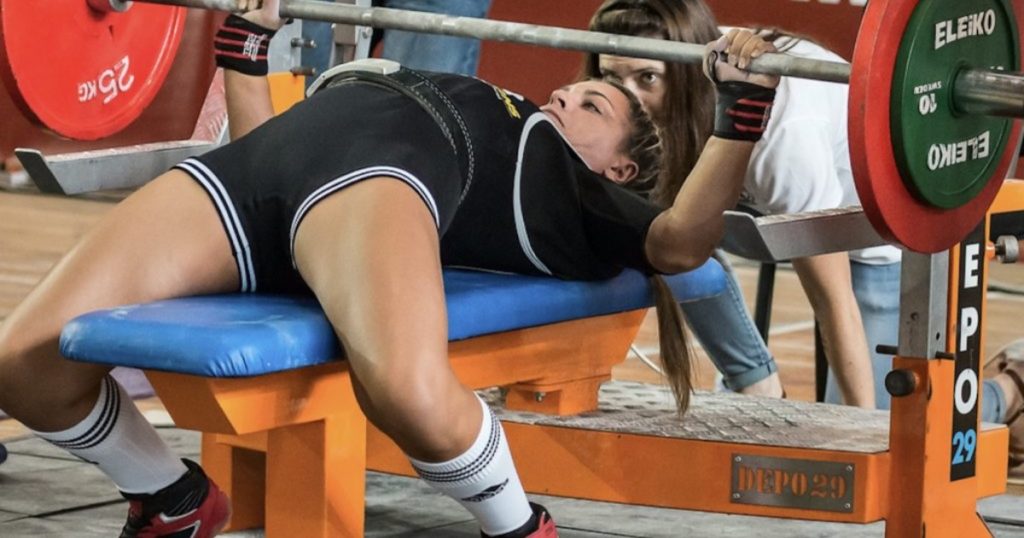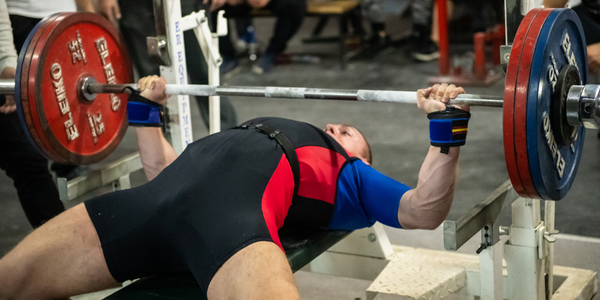Powerlifters often avoid group fitness classes like the plague: whether it’s because we’re often preferentially allergic to anything that might actually resemble cardio or because lifting can be such a solitary sport (and we like it that way), it might be rare that you find yourself in a class.
But if you’ve ever found yourself in a boxing class, you’ll know that there are a lot of things you learn in the ring that can definitely translate into more power on the platform.

Why Boxing Class?
It takes a certain kind of bravery to step onto a lifting platform, but it takes a whole different brand of courage to wrap up your hands and head into a boxing class. With powerlifting, you know what to do and you know what to expect, and once you know your cues and have your form locked in, it’s pretty much all in your head.
In boxing class, though, you’ve got a lot more active variables: what the instructor is going to pick for you all to focus on that day, who else is in the class with you, even how you vibe with what kind of jams the instructor is going to blast. But despite — or maybe because of — their differences, a powerlifter can learn a whole lot from boxing class.
Lesson One: High-Quality Form Before Intensity
If you have an instructor or coach that’s worth their proverbial salt, they’re going to emphasize form with you before they even let you strap on your gloves and hit a darn thing. They’re going to make sure that your wrists are stable, your elbows are tucked, your shoulders are relaxed, and that all the power is coming from your lower body. They’ll do all that, again and again and again, until you get it right consistently.

This can be super frustrating, and I get it. It looks much cooler to suit up and start pounding away at your target (there really is nothing quite like the sound of a crisp punch landing on the bag). And sure, it looks much cooler to slap a couple plates on either side of the bar and sink down into a knee-caved half squat…oh, wait. It doesn’t.
Because we might feel cooler with more weight on the bar, but if boxing teaches us anything, it’s that proper form looks much cooler than what you think your sport should look like. You’ll get there, whether it’s boxing, lifting, or both. But for now, and for always, keep checking in with your body to make sure your form is on point. Your much-less-likely-to-get-injured body will thank you.
Lesson Two: Better Stamina Means Better Performance
There’s a reason so many boxing classes will start with a few solid rounds of jumping rope: you need to build endurance, and a lot of it, to be anything close to a decent boxer. And yes, you lovely powerlifters who are concerned that anything resembling endurance will eat into your muscles — boxers are often absolutely jacked, and super strong. Their jump roping doesn’t kill that, and as long as you’re programming it right, it won’t kill yours.

Not to say that you have to jump rope, of course. But it’s important to make sure you’re getting at least some conditioning and endurance work in your lifting program. Because the more stamina you develop in your off-hours, the easier you’ll be able to bust out of the hole at the bottom of a heavy squat.
Lesson Three: Unlocking Your Ankles Is Key
I’ve seen far too many lifters try to squat with wobbly ankles, for a whole assortment of reasons. Inappropriate lifting shoes; lack of ankle flexibility; lack of ankle stability; trying to lift from a stance that doesn’t fit their body type. But in boxing class, you’ll learn to control your ankles, and — just as importantly — you’ll learn, in an intuitive way, how connected your ankles are to your hips and therefore, your torso and shoulders.
If your ankles are locked up, your hips will be locked up, and it will throw your whole kinetic chain off.
That’s why, in boxing class, you should be learning to rotate your foot (“unlock your ankle”) to initiate the hip power that goes into a solid cross. And while you won’t need to do this kind of rotation on the platform, the practice will help you develop a much more advanced kinesthetic awareness that will definitely translate into stronger lifts. Unsure of how leg drive can help stabilize your bench press?

Learning the ways that your upper and lower body are connected through such simple things as foot position will help integrate your entire kinetic chain and make for smarter, more intuitive lifts.
Lesson Four: Keep Your Hands Up
Okay, this one slants more metaphorical. You don’t literally have to keep your hands up while you’re training as a powerlifter — in boxing class, keeping your hands up will protect you from both your sparring partner and the potential ridicule of your coach. But in powerlifting (hopefully) not one is going to whack you with anything if your hands aren’t protecting your face. That said, it’s an important lesson to learn: because in boxing, you keep your hands up even when you only have an imaginary opponent.
Why? Because you’re building physical stamina, and because you’re building mental toughness. Physical stamina, because trust me, all your muscles will be screaming for you to drop your hands after a few solid rounds of taking it all out on the heavy bag. And mental toughness, because when your muscles are screaming that much, and when you’re already spending so much mental energy focusing on form…well, you’ll need it.

Just like you need both physical stamina and mental toughness on the lifting platform, because by that third squat at your meet, your body will already be starting to feel the exhaustion of the day. Adrenaline can only help so much: the rest is about trusting the strength you’ve built in training, and getting yourself in the right frame of mind to keep lifting your best.
Mental toughness — keeping your hands up — is exactly what you’re going to need when you’ve missed a lift and need to shake it off before crushing your next one.
Lesson Five: Transmit Force Through Your Core
In powerlifting, you’ve got to constantly focus on bracing your core to properly transmit force from your points of contact with the ground or bench to the bar. And you have to be as efficient about this force transfer as possible. In order to do that, you need to be super synced into the ways that your core serves as a force transmitter so that no energy leaks and all the force your muscles are producing actually go into the moving the bar.
Happily, boxing class will teach you all about this force transfer. Because in order to throw a proper punch, your core needs to be transmitting force from your lower body and hips into each punch. And, when you’re dodging and blocking properly, all that comes from your core, too. There’s a reason your obliques will probably be sore after boxing class, and that reason will clue you into the ways that your entire core should always be activated in your lifts, too.
Lesson Six: It’s Never Just Your Arms
When you deadlift, you’re not yanking the bar up from the ground with your arms (even thinking about it makes my biceps panic). Similarly — you’ll learn in boxing class — movements aren’t always what they look like. Because sure, the part of the body the average person will watch when someone right hooks someone else is the hands, the arms. But the force transfer, as discussed above, is not at all about your arms.
When you’re rotating into your punches the right way, the force will be coming from your lower body, from your hips — not from your arms. Sure, your arms need to be strong, but boxing class will teach you, super effectively, that your entire body is heavily involved in everything, even and perhaps especially in the movements that look like they’re all upper body.
Lesson Seven: Breathe Through Your Body
Knowing when to exhale is a cornerstone of both boxing and lifting. And while you might be super familiar with your breathing cues as a powerlifter, the breathing cues in boxing are sure to challenge you in a way that you might not have experienced in a while. Boxing’s quicker movements — and higher repetitions of these movements — are bound to leave most powerlifters gasping for breath.
And this gasping is actually a good thing: when you have to pause and re-think the way you’re breathing (and develop the appropriate lung capacity to keep your body going), it’s only going to improve your mind’s connection to your body’s breathing needs. And strengthening that connection is great for any powerlifter.

Whether it’s pre-meet anxiety or that last stabilizing, bracing breath before getting into the heaviest deadlift you’ve ever attempted, the sheer control over your breathing that you’ll learn in boxing will translate into smarter, more disciplined breath-work to accompany your lifts. And more disciplined breath work will only help you pack more weight onto the bar.
Get Punching To Improve Your Lifting
Mental grit, pure technique, physical stamina, force transmission, and breathwork: all hallmarks of great powerlifters and great boxers. And there are a lot of fresh ways boxing classes can teach you to reacquaint yourself with your body when you don’t have a barbell in your immediate proximity.
Diving into a boxing class, even if it’s just once, can give your body the jolt — and the extra connection to itself — that you need to get back to your lifting fresh, ready, and that much more equipped to lift with both power and efficiency.
Editor’s note: This article is an op-ed. The views expressed herein and in the video are the author’s and don’t necessarily reflect the views of BarBend. Claims, assertions, opinions, and quotes have been sourced exclusively by the author.
Feature image from Jacob Lund and Sportpoint on Shutterstock.